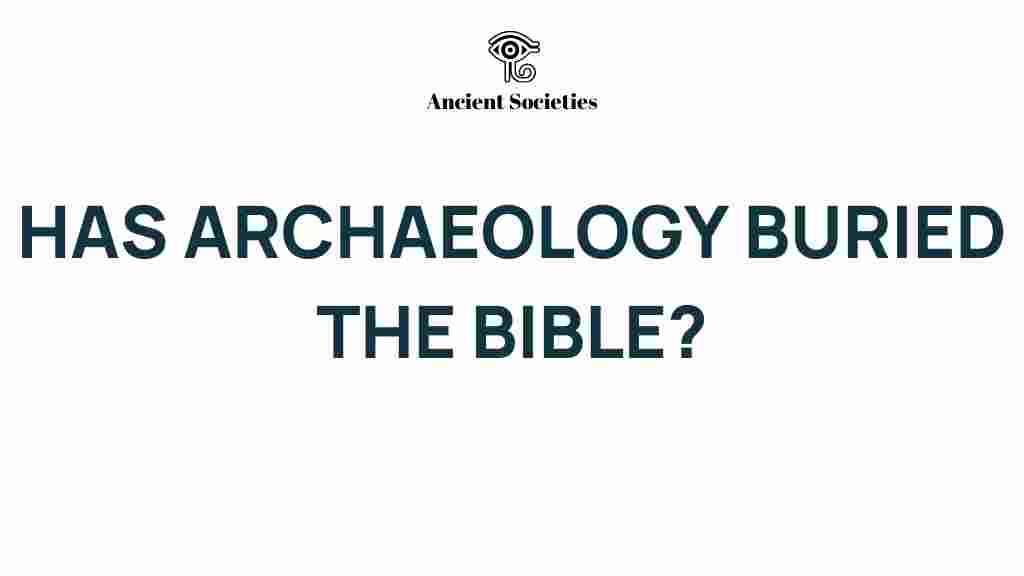Unearthing Truth: Has Archaeology Buried the Bible’s Secrets?
The relationship between archaeology and the Bible is a complex and often contentious one. As scholars and enthusiasts delve into the ancient world, they uncover artifacts and texts that either support or challenge biblical narratives. This article explores how archaeology has influenced the understanding of the Bible through historical evidence, ancient texts, and excavation efforts, while also considering the implications for religious studies and biblical history. We will uncover the truth behind the claim that archaeology has “buried” the secrets of the Bible.
The Role of Archaeology in Biblical Studies
Archaeology is the scientific study of human history and prehistory through the excavation of sites and the analysis of artifacts. In the context of the Bible, archaeology plays a crucial role in validating or questioning the historical accuracy of biblical accounts. Here are some key aspects of how archaeology intersects with biblical narratives:
- Artifacts: Objects from the past, such as pottery, inscriptions, and tools, provide tangible evidence of ancient civilizations.
- Excavation: Systematic digging at historical sites yields information about past cultures and their practices.
- Ancient Texts: Manuscripts and inscriptions can reveal insights into the beliefs and events described in the Bible.
Excavation Sites of Historical Significance
Several excavation sites have provided significant findings that relate to biblical history. These discoveries can enhance our understanding of ancient cultures and the context in which the biblical texts were written. Notable sites include:
- Jericho: Excavations have revealed layers of destruction that some scholars associate with the biblical account of Joshua.
- Qumran: The discovery of the Dead Sea Scrolls has shed light on the textual history of the Bible.
- Megiddo: This site has uncovered evidence of various battles, aligning with biblical narratives regarding military confrontations.
Historical Evidence Supporting Biblical Narratives
While some archaeological findings have confirmed elements of biblical accounts, others have proven more contentious. Here are a few examples of how archaeology has supported or contradicted biblical narratives:
- The Hittites: Once thought to be a biblical myth, archaeological evidence has confirmed the existence of this ancient civilization.
- King David: Inscriptions found in the Tel Dan Stele reference a “House of David,” providing historical evidence for his reign.
- Exodus and the Conquest: The lack of concrete archaeological evidence for the Exodus has led to debates regarding its historicity.
Controversies and Debates in Archaeology and the Bible
Despite the advancements in archaeological methods and discoveries, debates continue regarding the interpretation of findings related to the Bible. Some controversies include:
– The interpretation of the archaeological record: Different scholars may have varying views on what specific findings mean in the context of the Bible.- The historicity of miraculous events: Many biblical narratives include miracles, which are challenging to validate through archaeology.- The role of faith: For many believers, the Bible is a matter of faith, and archaeological evidence may not sway their convictions.
Step-by-Step Process: How Archaeologists Approach Biblical Sites
Understanding how archaeologists work can demystify the process of uncovering ancient truths. Here’s a step-by-step overview:
- Site Selection: Archaeologists choose sites based on historical texts, local traditions, or previous findings.
- Surveying: Initial surveys help identify potential areas for excavation by analyzing surface artifacts.
- Excavation: Systematic digging is conducted, often in layers, to preserve the context of artifacts.
- Documentation: All findings are meticulously recorded, including photographs, sketches, and notes.
- Analysis: Artifacts are analyzed in laboratories to determine their age, composition, and significance.
- Publication: Findings are shared with the academic community and the public, contributing to ongoing discussions.
For individuals grappling with the implications of archaeological findings on their faith, here are some tips:
- Stay Informed: Read widely from both biblical scholars and archaeologists to understand varying perspectives.
- Engage in Discussions: Participate in study groups or online forums to discuss findings and their implications.
- Reflect on the Nature of Faith: Consider how faith and historical evidence can coexist, allowing for a nuanced understanding of belief.
For more in-depth discussions on the intersection of faith and archaeology, check out this resource.
Conclusion: The Ongoing Journey of Discovery
As we explore the relationship between archaeology and the Bible, it becomes clear that the journey is ongoing. Archaeology has not buried the secrets of the Bible; instead, it has illuminated many aspects of biblical history while raising new questions. The evidence uncovered through excavation and the artifacts discovered continue to challenge, reaffirm, and enrich our understanding of ancient texts.
Ultimately, the dialogue between faith and historical evidence is vital. As both fields evolve, they provide a richer tapestry of human understanding. The truth unearthed through archaeology invites us to reconsider our perspectives on ancient beliefs and the narratives that shape our spiritual lives.
By embracing both faith and the insights offered by archaeology, we can find a harmonious balance that respects the past while illuminating the path forward.
This article is in the category Archaeology and created by AncientSocieties Team
